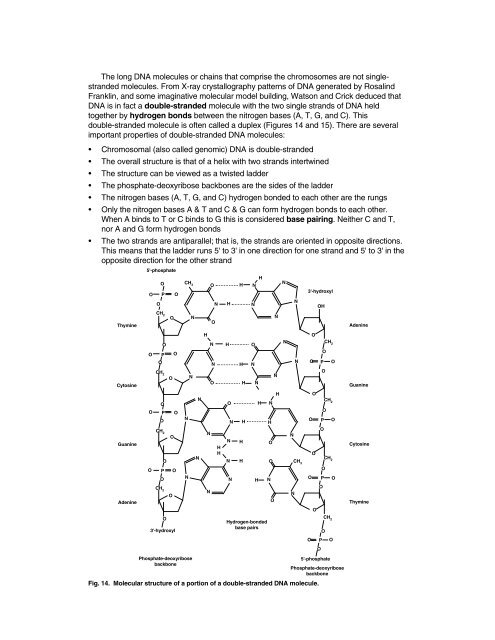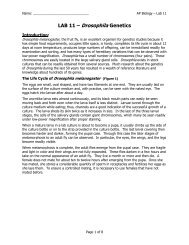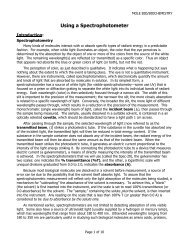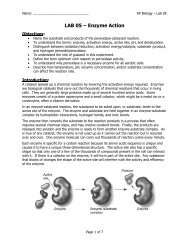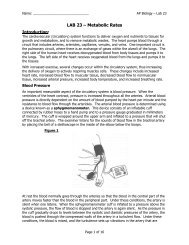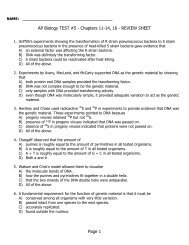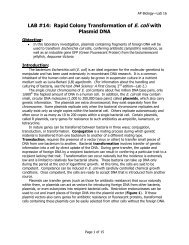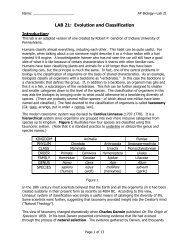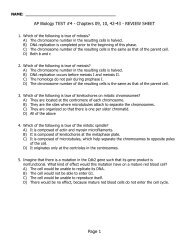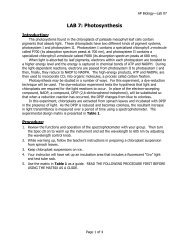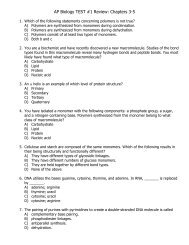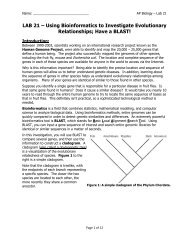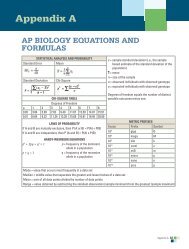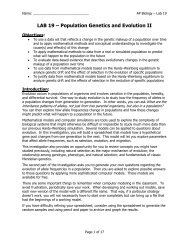Crime Scene Investigator PCR Basics⢠Kit
Crime Scene Investigator PCR Basics⢠Kit
Crime Scene Investigator PCR Basics⢠Kit
Create successful ePaper yourself
Turn your PDF publications into a flip-book with our unique Google optimized e-Paper software.
The long DNA molecules or chains that comprise the chromosomes are not singlestranded<br />
molecules. From X-ray crystallography patterns of DNA generated by Rosalind<br />
Franklin, and some imaginative molecular model building, Watson and Crick deduced that<br />
DNA is in fact a double-stranded molecule with the two single strands of DNA held<br />
together by hydrogen bonds between the nitrogen bases (A, T, G, and C). This<br />
double-stranded molecule is often called a duplex (Figures 14 and 15). There are several<br />
important properties of double-stranded DNA molecules:<br />
• Chromosomal (also called genomic) DNA is double-stranded<br />
• The overall structure is that of a helix with two strands intertwined<br />
• The structure can be viewed as a twisted ladder<br />
• The phosphate-deoxyribose backbones are the sides of the ladder<br />
• The nitrogen bases (A, T, G, and C) hydrogen bonded to each other are the rungs<br />
• Only the nitrogen bases A & T and C & G can form hydrogen bonds to each other.<br />
When A binds to T or C binds to G this is considered base pairing. Neither C and T,<br />
nor A and G form hydrogen bonds<br />
• The two strands are antiparallel; that is, the strands are oriented in opposite directions.<br />
This means that the ladder runs 5' to 3' in one direction for one strand and 5' to 3' in the<br />
opposite direction for the other strand<br />
5'-phosphate<br />
O<br />
O<br />
O<br />
P<br />
O<br />
CH 3<br />
O<br />
N<br />
H<br />
H<br />
N<br />
N<br />
H<br />
N<br />
N<br />
3'-hydroxyl<br />
OH<br />
Thymine<br />
Cytosine<br />
Guanine<br />
Adenine<br />
CH 2<br />
O<br />
N<br />
CH 2<br />
H<br />
O<br />
O<br />
N H O<br />
N<br />
CH O<br />
2<br />
N<br />
O<br />
N<br />
O P O<br />
O<br />
O<br />
N<br />
H N<br />
N O P O<br />
CH O<br />
2<br />
N<br />
N<br />
O<br />
O<br />
H N<br />
H<br />
O<br />
O<br />
N<br />
O<br />
H N<br />
CH 2<br />
O P O<br />
O<br />
O<br />
N<br />
N H H<br />
O P O<br />
CH O<br />
2<br />
N<br />
O<br />
N<br />
N H<br />
O<br />
H<br />
H<br />
O<br />
O<br />
N<br />
N H<br />
O CH 3<br />
CH 2<br />
O P O<br />
O<br />
O<br />
N<br />
N H N<br />
O P O<br />
O<br />
O<br />
3'-hydroxyl<br />
Phosphate-deoxyribose<br />
backbone<br />
Fig. 14. Molecular structure of a portion of a double-stranded DNA molecule.<br />
O<br />
Hydrogen-bonded<br />
base pairs<br />
50<br />
N<br />
O<br />
O<br />
P<br />
O<br />
O<br />
CH 2<br />
5'-phosphate<br />
O<br />
Phosphate-deoxyribose<br />
backbone<br />
Adenine<br />
Guanine<br />
Cytosine<br />
Thymine


